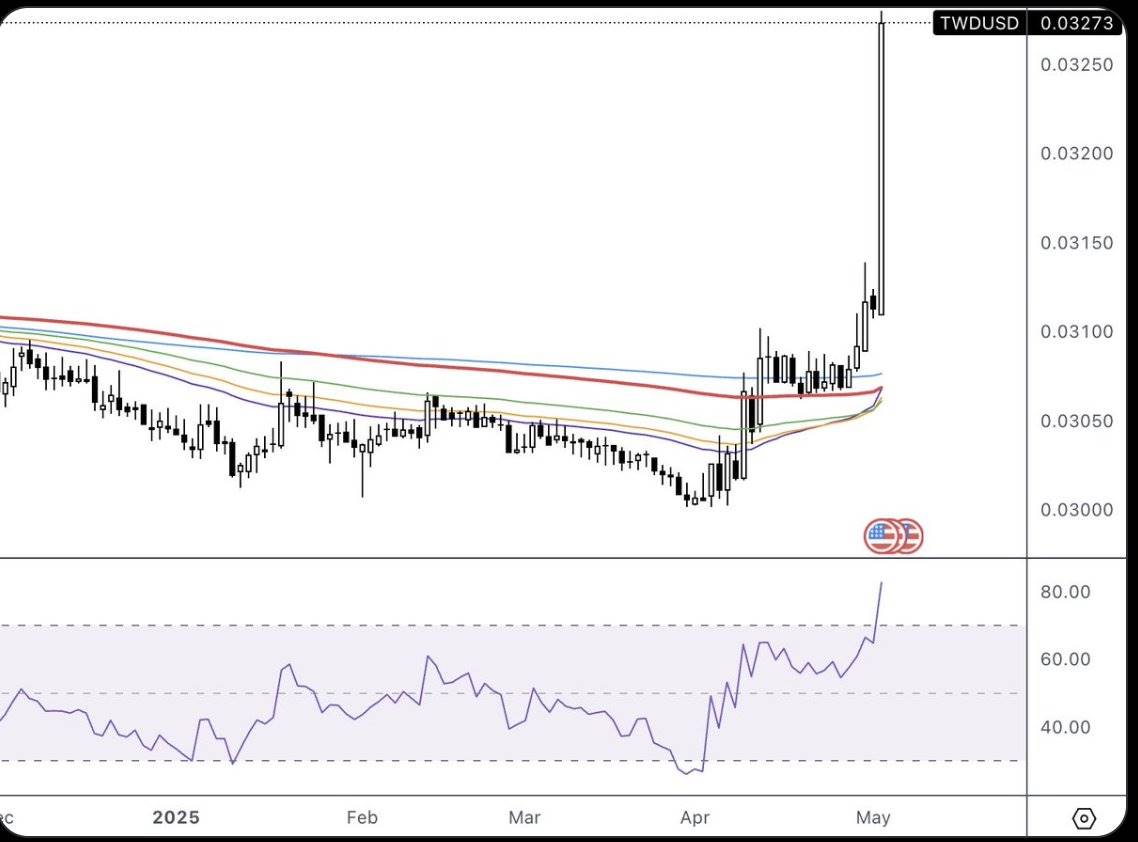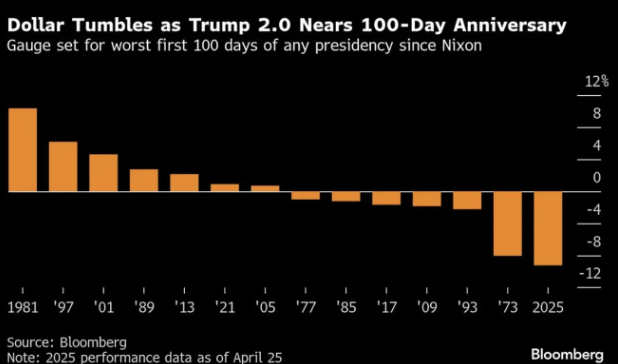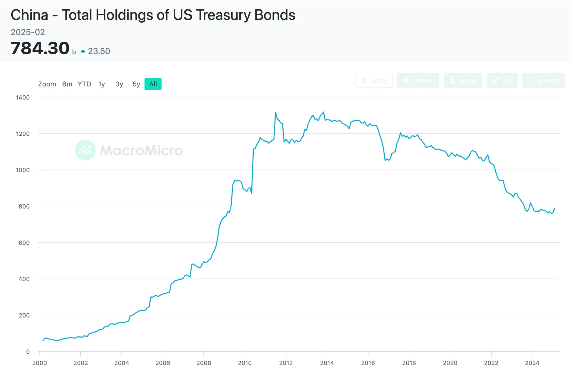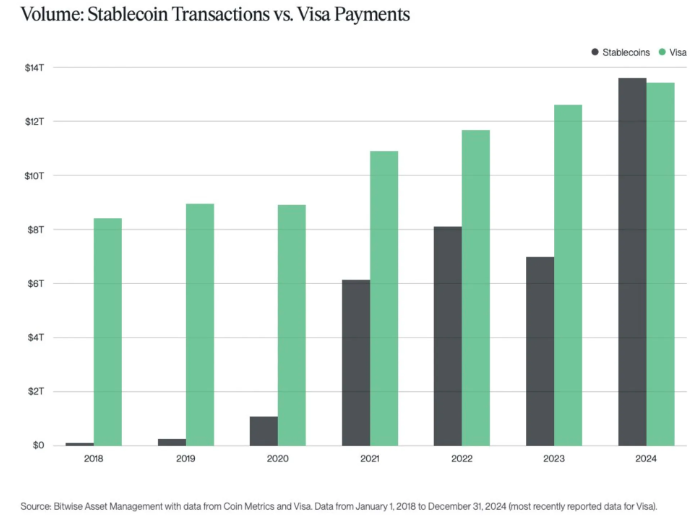Global liquidity is quietly converging in a borderless decentralized financial network.
Author: Tony
Translation: Deep Tide TechFlow
Convergence and Divergence: US-China Relations, CeDeFi, and De-dollarization
Recently, the dramatic fluctuations in the currency market have highlighted the escalating macroeconomic tensions and significant changes in global financial dynamics. The USD/JPY has rapidly climbed to the 145 level, primarily due to the Bank of Japan's continued accommodative stance—keeping interest rates unchanged and not signaling an immediate tightening of policy—along with the unwinding of long positions in the yen. The interest rate differential remains pronounced, with the dollar holding an advantage as the Federal Reserve maintains relatively high rates while Japan adopts a loose monetary policy.
At the same time, the New Taiwan Dollar (TWD) surged over 8% against the dollar within two days, marking an extremely rare "19-sigma" event. This sudden change was due to Taiwanese institutions quickly readjusting their dollar exposure, underscoring growing concerns over geopolitical risks and vividly demonstrating the real impact of escalating US-China tensions on the global currency market.

TSD/USD Price Chart
Earlier this month, geopolitical tensions between the US and China escalated sharply as President Trump raised tariffs on Chinese imports to an unprecedented 145%. China swiftly retaliated with a 125% tariff on US goods, further deepening economic divergence.
This escalation echoes the classic "Thucydides Trap," a historical pattern predicting that conflict is inevitable when a rising power challenges an existing hegemon. Far beyond trade barriers, this event marks a systemic decoupling of the world's two largest economies, with significant secondary effects rippling through global liquidity and the dollar's dominance.
For a long time, the dollar's ubiquity in global trade and finance has been built on an implicit yet profound trust in US institutions—this trust is based on stable governance, predictable foreign policy, and minimal barriers to capital flows. As Bipan Rai, Managing Director at BMO Global Asset Management, stated: "There are clear signs of erosion… pointing to a structural shift in global asset allocation trends away from the dollar."
Indeed, the foundation of dollar hegemony is quietly fracturing under the pressures of geopolitical volatility and increasingly unpredictable US foreign and economic policies. Notably, despite President Trump's stern warnings that countries attempting to abandon dollar-based trade would face economic penalties, the dollar experienced its most severe depreciation since the Nixon era during his presidency.
This symbolic moment underscores a broader, accelerating trend: Countries around the world are actively seeking alternatives to the US-dominated financial system, marking a gradual shift towards global de-dollarization.

For decades, China's trade surplus has seen dollars flow back into US Treasuries and financial markets, supporting the dollar's hegemony after the collapse of the Bretton Woods system. However, with the sharp deterioration of strategic trust between the US and China in recent years, this long-standing capital cycle faces unprecedented disruption.
China, traditionally the largest foreign holder of US assets, has significantly reduced its exposure, with US Treasury holdings dropping to about $760.8 billion by early 2025, nearly a 40% decline from the peak in 2013. This change reflects a broader strategic response by China to the risks associated with potential US economic sanctions, which have previously led to large-scale asset freezes—most notably the approximately $350 billion in reserves of the Russian central bank frozen in 2022.
As a result, Chinese policymakers and influential economists are increasingly advocating for the diversification of China's reserve assets away from the dollar, fearing that dollar-denominated assets are becoming geopolitical liabilities.
This strategic reconfiguration includes a significant increase in gold reserves—approximately 144 tons added in 2023 alone—and efforts to enhance the global use of the renminbi and explore alternatives to digital currencies. This systemic de-dollarization is tightening global dollar liquidity, raising international financing costs, and posing significant challenges to markets accustomed to China recycling its surplus dollars back into the Western financial system.

Source: MacroMicro
Additionally, China is actively advocating for the establishment of a multipolar financial order, encouraging developing countries to increasingly use local currencies or renminbi for trade instead of the dollar. At the core of this strategy is the Cross-Border Interbank Payment System (CIPS), explicitly designed as a comprehensive global alternative to the existing SWIFT and CHIPS networks, covering information transmission (SWIFT) and settlement (CHIPS) functions. Since its launch in 2015, CIPS aims to simplify international transactions priced directly in renminbi, thereby reducing global reliance on US-dominated financial infrastructure. Its widespread acceptance marks a systemic shift towards financial multipolarity: by the end of 2024, CIPS had attracted participation from 170 direct and 1,497 indirect institutional members across 119 countries and regions.
Reportedly, this stable growth peaked on April 16, 2025, when unconfirmed reports announced that CIPS's daily transaction volume surpassed SWIFT for the first time, processing a record 12.8 trillion renminbi (approximately $1.76 trillion).
Although not yet officially confirmed, this milestone undoubtedly emphasizes the transformative potential of Chinese financial infrastructure in reshaping global currency dynamics, shifting from dollar centralization to a decentralized, multipolar system centered around the renminbi.
"In the past decade, trade denominated in renminbi has grown from zero to 30%, and half of China's capital flows are now conducted in renminbi, far exceeding previous levels."
—Keyu Jin (Economist at the London School of Economics), speaking at a panel discussion hosted by the Milken Institute
Liquidity Must Flow: The Convergence of CeDeFi
However, as geopolitical boundaries intensify and traditional financial channels narrow, a parallel phenomenon is emerging: global liquidity is quietly converging in a borderless decentralized financial network. The convergence of liquidity between CeFi, DeFi, and TradFi represents a repositioning of capital flows, making blockchain-based networks a key financial infrastructure reshaping the global economy.
Specifically, the convergence of CeDeFi is driven by multiple gravitational factors:
Stablecoins as a means of payment bring B2B (business-to-business) and B2C (business-to-consumer) liquidity on-chain.
CeFi (centralized finance) institutions cross-provide cryptocurrency and traditional financial products.
DeFi (decentralized finance) protocols connect on-chain and off-chain yields, creating new interest rate arbitrage opportunities.
Stablecoins as Payment Infrastructure
Payments have always been the "holy grail" of cryptocurrency.
Tether, as the de facto shadow bank of offshore dollars, has become the most profitable financial institution for every employee. Recent geopolitical turmoil will only intensify the demand for stablecoins, as global capital increasingly seeks a censorship-resistant and borderless platform to gain dollar exposure. Whether it’s Argentine savers using USDC to hedge against inflation or Chinese merchants using Tether to settle trade outside the banking system, the driving force is the same: obtaining reliable value without the friction of traditional systems.
In an era of geopolitical tension and financial uncertainty, this demand for "transaction autonomy" is highly appealing. By 2024, the trading volume of stablecoins has surpassed that of Visa. Ultimately, cryptocurrency-based digital dollars (stablecoins) are replicating the offshore dollar network of the 20th century—providing dollar liquidity outside US banking channels, especially in markets wary of US hegemony.

CeFi Institutions Cross-Providing Traditional Finance and Crypto Products
In addition to allowing global liquidity to settle in dollars, we are also seeing CeFi platforms vertically expand into cryptocurrency, and vice versa:
Kraken acquired Ninja Trading to expand its product offerings to traditional financial assets, ultimately allowing cross-margining between traditional finance and crypto trading.
In China, major brokerages like Tiger Brokers and Futu Securities (often referred to as China's Robinhood) have begun accepting deposits in USDT, ETH, and BTC.
Robinhood has strategically positioned cryptocurrency as a core growth priority, planning to launch products like tokenized stocks and stablecoins.
As upcoming market structure legislation brings more regulatory clarity, the horizontal expansion of products crossing cryptocurrency and traditional finance will become increasingly important.
DeFi Protocols Connecting Crypto and Traditional Financial Yields
Meanwhile, we are also seeing DeFi protocols leverage competitive crypto-native yields to attract traditional finance/off-chain capital, allowing traditional financial institutions to utilize global on-chain liquidity to execute their off-chain strategies.
For example, our portfolio companies BounceBit (@bouncebitand) and Ethena (@ethenalabs) provide basis trading yields for traditional financial institutions. Due to the programmability of on-chain dollars, they are able to package this basis trading product into synthetic dollars on-chain, directly targeting the $13 trillion fixed income market. For traditional financial institutions, this product may be particularly attractive as basis trading yields are negatively correlated with Treasury yields. Thus, they essentially form a new interest rate arbitrage pathway, forcing capital flows and interest rate markets to converge between CeFi, DeFi, and TradFi.
Additionally, Cap Lab (@capmoney_) allows traditional financial institutions to borrow from on-chain liquidity pools to execute off-chain trading strategies, thereby providing retail investors with unprecedented access to complex high-frequency trading (HFT) yields. It effectively expands the economic security product range of EigenLayer from on-chain economic activities to off-chain yield generation strategies.
Overall, these developments are driving liquidity convergence, compressing the spreads between on-chain yields, off-chain yields, and traditional risk-free rates. Ultimately, these innovative solutions serve as powerful arbitrage tools, aligning capital flows and interest rate dynamics across the DeFi, CeFi, and TradFi sectors.
CeDeFi Liquidity Convergence -> CeDeFi Product Offering
The convergence of liquidity from CeFi (Centralized Finance), DeFi (Decentralized Finance), and TradFi (Traditional Finance) into blockchain networks marks a fundamental shift for on-chain asset allocators—from primarily crypto-native traders to increasingly complex institutions seeking diversified exposure that transcends crypto-native assets and yields. The downstream effect of this trend is the broad expansion of on-chain financial product offerings, with more real-world asset (RWA) products being introduced on-chain. As more RWA products come online, it will once again attract institutions from around the world into the on-chain space, creating a reinforcing cycle that ultimately brings all financial participants and financial assets into a unified global ledger.
Historically, the trajectory of cryptocurrencies has continuously incorporated higher-quality real-world assets, evolving from stablecoins and tokenized Treasury bills (such as Franklin Templeton's Benji and BlackRock's BUIDL) to increasingly complex instruments like Apollo's recently tokenized private credit fund, with the potential to further expand into tokenized equities. The declining appetite of marginal buyers for speculative crypto-native assets highlights a significant market gap and presents an opportunity for institutional-grade tokenized RWAs. Against the backdrop of escalating global geopolitical uncertainty—such as the decoupling tensions between major economies like the US and China—blockchain technology is emerging as a trusted neutral financial infrastructure. Ultimately, all financial activities, from trading speculative crypto-native altcoins to payments, tokenized Treasury bills, and equities, will converge onto this verifiable and borderless global financial ledger, fundamentally reshaping the global economic landscape.
免责声明:本文章仅代表作者个人观点,不代表本平台的立场和观点。本文章仅供信息分享,不构成对任何人的任何投资建议。用户与作者之间的任何争议,与本平台无关。如网页中刊载的文章或图片涉及侵权,请提供相关的权利证明和身份证明发送邮件到support@aicoin.com,本平台相关工作人员将会进行核查。




